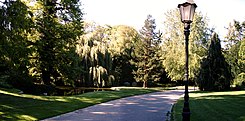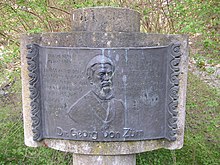Ringpark
| Ringpark | |
|---|---|
| Park in Würzburg | |

|
|
| Ringpark near Little Nice | |
| Basic data | |
| place | Wurzburg |
| District | Old town |
| Created | 1878-1896 |
| Surrounding streets |
|
| Technical specifications | |
| Parking area | 34 ha |
The Ringpark (also called Glacis ) is a green area around the old town of Würzburg . It was created in the area of the ramparts that were razed in the 19th century .
history
The Würzburg Glacis initially consisted of an area surrounded by walls and ramparts, sloping slightly outwards and up to 50 meters wide. A poplar avenue was laid out in front of the city ramparts in 1804. The glacis then served as pasture, arable land, gardening and viticulture as well as for drill purposes and was increasingly designed as a park from 1820 onwards. In 1868 the city of Würzburg bought the glacis site from the Kingdom of Bavaria . Walls and bastions and works were demolished in the course of the softening that began in 1870, and the trenches up to 12 meters deep were filled in.
At the initiative of the mayor at the time, Georg von Zürn , inspired by the Ringstrasse he had seen in Vienna , the construction of the park that was created through the redesign of the former glacis was tackled in 1878. The first section around the war memorial was designed by Heinrich Siesmayer . Then the Swedish landscape architect Jens Person Lindahl , who was the first full-time city gardener of Würzburg from August 1880 to 1887, designed the Würzburg Ringpark and realized it by 1886.). Characteristics of his landscape design are curved paths, groups of trees, bodies of water and a scenic hill relief. Probably because of financial difficulties and disputes about the ring park with the citizens that had begun in 1885 or constant quarrels with the municipal representatives, he shot himself and was found dead on November 22, 1887 in the ring park in the glacis on Ottostraße. Engelbert Sturm, Lindahl's successor as city gardener, then designed the Klein- Nice , a pond and flower landscape along the fortification of the courtyard garden. At the time, this cost 85,400 marks. (Today the equivalent of around 601,132 euros.) With the pond system, the entire system of the Ringpark was completed in 1900 and completed on July 8, 1903 with a memorial near the train station for Prince Regent Luitpold, who was born in Würzburg .
Course and meaning
The oxygen- donating green belt runs in a semicircle around the old town from the banks of the Main at the Friedensbrücke to the banks of the Main at the Ludwigsbrücke (Lion Bridge). It takes the place of the glacis on the former open field in front of the baroque city wall . It is approx. 3.5 km long, up to 240 m wide and has an area of approx. 34 hectares . It is interrupted by the main train station and Berliner Platz, and borders the main cemetery and the court garden of the Residenz , from which it is separated by part of the former fortification walls.
The park in the style of an English landscape garden is one of the few ring parks in Germany from the end of the 19th century that are still well preserved today.
As the “green lung” of the city of Würzburg with 35 tree species, the Ringpark generates oxygen, compensates for the climatic drought and uses evaporation to reduce temperature peaks in summer.
biodiversity
With over 300 different native and exotic woody species, it is also one of the most species-rich parks in Germany. Striking and exotic trees in the park are marked with German and Latin names. There are also numerous monuments and fountains on the site. Trees and trees come from China, North America and Europe. Blooming flowers are always used anew according to the season. 43 species of birds were observed.
Monuments
Numerous monuments remind of historical events:
- Fragment of the wall at Berliner Platz
- War memorial in the area between Husarenstrasse and Rennweg
Trivia
The Ringpark Festival takes place every year in August in Little Nice. The city of Würzburg is the organizer of this community festival with a small stage, musical performances and children's program.
literature
- Environment department and city archive Würzburg (ed.): The Würzburger Ringpark . Cultural monument and recreational area. Verlag Ferdinand Schöningh , Würzburg 1996, ISBN 3-87717-778-6 .
- Ulrich Wagner: Jens Person Lindahl - designer of the Würzburger Ringpark. In: Ulrich Wagner (Hrsg.): History of the city of Würzburg. 4 volumes; Volume III / 1–2: From the transition to Bavaria to the 21st century. Theiss, Stuttgart 2007, ISBN 978-3-8062-1478-9 ), pp. 61-63 and 1253.
- Harm-Hinrich Brandt : Würzburg local politics 1869-1918. In: Ulrich Wagner (Hrsg.): History of the city of Würzburg. 4 volumes; Volume III / 1–2: From the transition to Bavaria to the 21st century. Theiss, Stuttgart 2007, ISBN 978-3-8062-1478-9 ), pp. 64-166 and 1254-1267; here: pp. 100 and 134–138.
Web links
Individual evidence
- ↑ a b c d Ringpark. City of Würzburg, 2018, accessed on April 29, 2019 .
- ^ Horst-Günter Wagner : The urban development of Würzburg 1814-2000. In: Ulrich Wagner (Hrsg.): History of the city of Würzburg. 4 volumes, Volume I-III / 2, Theiss, Stuttgart 2001-2007; III / 1–2: From the transition to Bavaria to the 21st century. 2007, ISBN 978-3-8062-1478-9 , pp. 396-426 and 1298-1302, here: pp. 397 f.
- ^ Wilhelm Engel in: Willy Schmitt-Lieb, Wilhelm Engel: Würzburg in the picture. Wisli-Mappe, Würzburg 1956, p. 17.
- ↑ Horst-Günter Wagner (2007), p. 399.
- ^ City of Würzburg, Garden Department and Own Business Congress, Tourism, Economy (Ed.): Würzburger Gardens and Parks. Leaflet around 2003.
- ↑ Winfried Schenk, Rüdiger Glaser , Moritz Nestle: Würzburg's environment in the transformation from the pre-industrial era to the service society. In: Ulrich Wagner (Hrsg.): History of the city of Würzburg. 4 volumes, Volume I-III / 2 (I: From the beginnings to the outbreak of the Peasant War. 2001, ISBN 3-8062-1465-4 ; II: From the Peasant War 1525 to the transition to the Kingdom of Bavaria 1814. 2004, ISBN 3 -8062-1477-8 ; III / 1–2: From the transition to Bavaria to the 21st century. 2007, ISBN 978-3-8062-1478-9 ), Theiss, Stuttgart 2001–2007, Volume III (2007), Pp. 351-368 and 1295 f., Here: p. 354.
- ↑ Jens (also Jöns) person Lindahl had already shown his skills when designing the Landgrave Hessian park in Philippsruhe near Hanau. See Wilhelm Engel (1956), p. 17.
- ^ Horst-Günter Wagner: The urban development of Würzburg 1814-2000. 2007, p. 409.
- ^ Harm-Hinrich Brandt : Würzburg municipal policy 1869-1918. In: Ulrich Wagner (Hrsg.): History of the city of Würzburg. 4 volumes; Volume III / 1–2: From the transition to Bavaria to the 21st century. Theiss, Stuttgart 2007, ISBN 978-3-8062-1478-9 ), pp. 64-166 and 1254-1267; here: p. 100.
- ^ Sybille Grübel: Timeline of the history of the city from 1814-2006. In: Ulrich Wagner (Hrsg.): History of the city of Würzburg. 4 volumes, Volume I-III / 2, Theiss, Stuttgart 2001-2007; III / 1–2: From the transition to Bavaria to the 21st century. Volume 2, 2007, ISBN 978-3-8062-1478-9 , pp. 1225-1247; here: p. 1232.
- ↑ Ulrich Wagner (2007), p. 62 f.
- ^ City of Würzburg, Garden Department and Own Business Congress, Tourism, Economy (Ed.): Würzburger Gardens and Parks. Leaflet around 2003.
- ^ Sybille Grübel: Timeline of the history of the city from 1814-2006. 2007, p. 1234.
- ↑ Ulrike Schulz: The signposted tree species in the glacis .
- ↑ Winfried Schenk, Rüdiger Glaser , Moritz Nestle: Würzburg's environment in the transformation from the pre-industrial era to the service society. In: Ulrich Wagner (Hrsg.): History of the city of Würzburg. 4 volumes, Volume I-III / 2 (I: From the beginnings to the outbreak of the Peasant War. 2001, ISBN 3-8062-1465-4 ; II: From the Peasant War 1525 to the transition to the Kingdom of Bavaria 1814. 2004, ISBN 3 -8062-1477-8 ; III / 1–2: From the transition to Bavaria to the 21st century. 2007, ISBN 978-3-8062-1478-9 ), Theiss, Stuttgart 2001–2007, Volume III (2007), Pp. 351-368 and 1295 f., Here: p. 361.
- ^ City of Würzburg, Garden Department and Own Business Congress, Tourism, Economy (Ed.): Würzburger Gardens and Parks. Leaflet around 2003.
Coordinates: 49 ° 47 ′ 28 ″ N , 9 ° 56 ′ 28 ″ E







